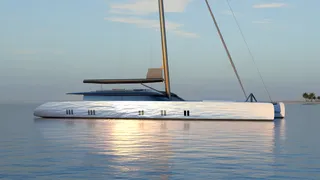A new, collaborative 50.4-metre sailing catamaran concept known as Project Elemental promises to bridge the gap between motor yacht luxury and the thrill of sailing. Holly Margerrison joined the team behind the design for a lunch at Quai des Artistes during the Monaco Yacht Show to explore how this ambitious project combines performance, comfort and sustainability in a vessel designed to appeal to seasoned sailors and motor yacht owners alike...
Unveiled exclusively to BOAT, Project Elemental marks an ambitious step for Tripp Design Naval Architecture and British studio Design Unlimited, with brokerage Superyacht Partners bringing the project to market. Away from the bustle of the boat show, the conversation revealed that the catamaran is not just about size – it’s about reshaping perceptions of what large sailing yachts can offer.
"We wanted something exciting, but not too exciting – fun to sail at 18 knots, but never white-knuckle," Bill Tripp of Tripp Design explained. "It’s about balance: a yacht that can open up the globe for its owner without ever feeling out of control."
Tripp highlighted that the boat is designed to attract owners who aren’t fond of the heeling of a racing yacht, while still offering the space, luxury and versatility typically associated with motor yachts. "With sailing, you can go anywhere, generate power while reducing fuel use and take full control of your journey."
Leading yacht broker Will Bishop of Superyacht Partners added that hybrid and regenerative systems essentially take range out of the equation: "You’re giving yourself a far greater range than any motor yacht while burning much less fuel."
Tripp emphasised safety, noting that the catamaran is inherently stable: "This isn’t a boat that capsizes in strong winds. You want it exhilarating, but never terrifying."
The design team has carefully considered scale, too. "At 50.4 metres, the hull volume gives us freedom to create generous interiors without compromising sailing performance," Mark Tucker of Design Unlimited explained. "It’s important to balance open social spaces with cosy corners for privacy."
This focus on liveability is evident in the yacht’s layout: the owner’s duplex suite is on the main deck with panoramic views, four guest cabins and a VIP suite are set below, while informal spaces such as trampolines forward and a beach club and spa aft provide variety for longer cruises.
Tripp’s wife and colleague, Danielle Massé, highlighted how modern owners increasingly live aboard for months at a time. "They need spaces that flex – lively social areas with guests, but private corners to read or relax," she said. "That’s one of the big advantages of a catamaran – the volume allows for both togetherness and retreat." Bishop noted the flybridge design enhances social interaction without crowding the guests, allowing simultaneous enjoyment of sailing and leisure.
Crew considerations are equally central. Private cabins for captain and mate, plus four double cabins, a watersports room and tender stowage, ensure smooth operations. Tripp explained, “If the crew are comfortable and the systems are simple, the entire guest experience improves.” The yacht’s sailing systems are deliberately straightforward: three sails cover nearly every scenario, allowing the vessel to be sailed safely and efficiently.
Aluminium Alustar hulls and moderate displacement are central to achieving the so-called "Goldilocks" balance: too heavy compromises performance; too light makes the sail plan unmanageable. At 1,230 square metres, the sail plan has been engineered for safety, controllability and excitement. Tripp described the design philosophy: "We took the opposite of typical racing designs – fewer, larger sails that are simple to deploy."
Sustainability is another key driver. "Regeneration systems reduce reliance on fuel. You can go anywhere without compromising the environment," Massé noted. This aligns with a growing market trend, where owners increasingly seek aspirational yet responsible yachting experiences.
Project Elemental will be offered as a customisable platform rather than a speculative build. The concept builds on Tripp Design’s experience with large, cruising sailing yachts like Alithia (now 4K) and Aquijo, while Design Unlimited contributes interiors that rival the comfort of motor yachts. Tucker reflected: "We wanted to bring the right level of luxury and comfort for owners transitioning from powerboats into sailing yachts, using space intelligently without losing intimacy or warmth."
Bishop emphasised that client insights were crucial: "We’ve seen boats that try to be everything to everyone and fail. This catamaran is designed to deliver a sailing experience that’s efficient, enjoyable and well-built, rather than a block of flats with sails." The project also benefits from lessons learned on smaller, fully sail-powered vessels, where wind regeneration powers batteries, feeding into the larger 50-metre design.
At its heart, Project Elemental celebrates the joy of sailing. As Massé explained: "That moment when the engine stops, the sails go up and there’s just silence and wind – that’s what this boat is designed to deliver." Tripp concluded, "We’re not compromising. We’re finding balance – the right mix of performance, comfort and control to sail the globe with confidence and pleasure."

